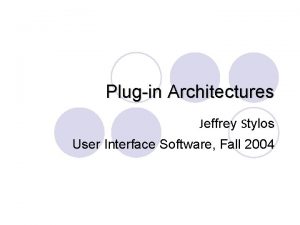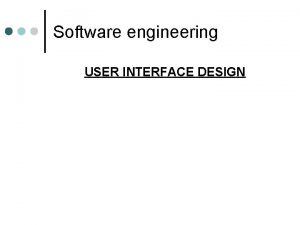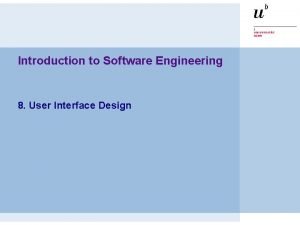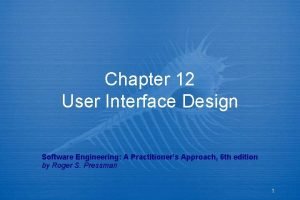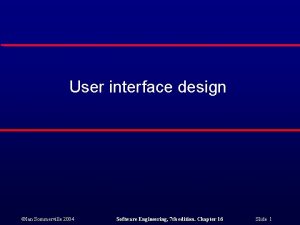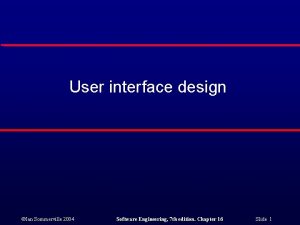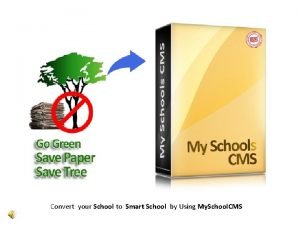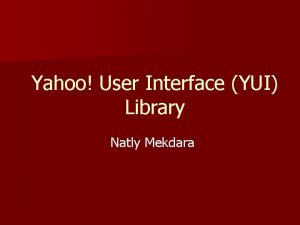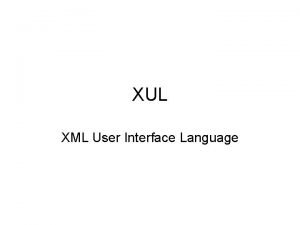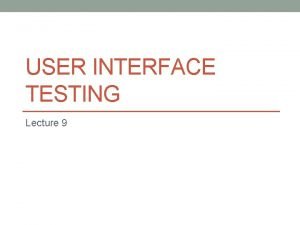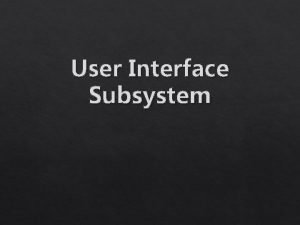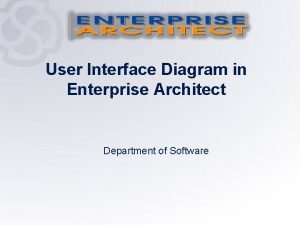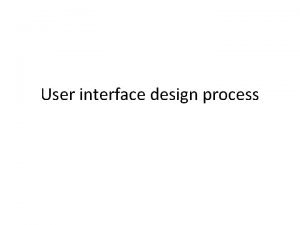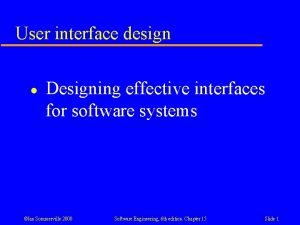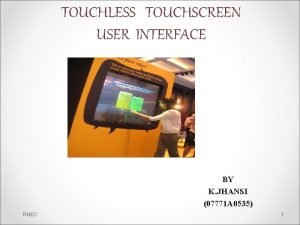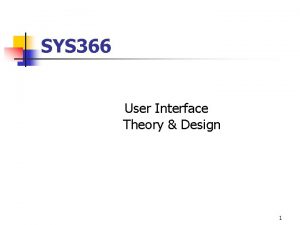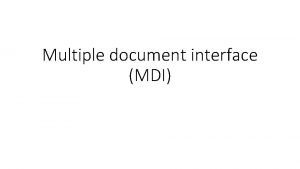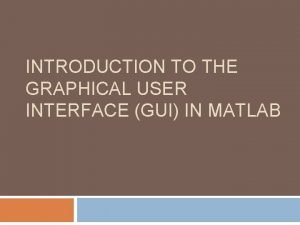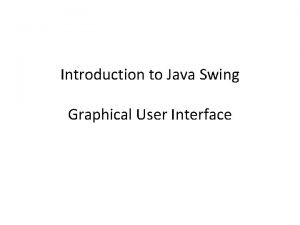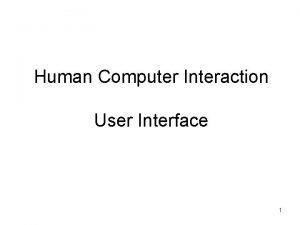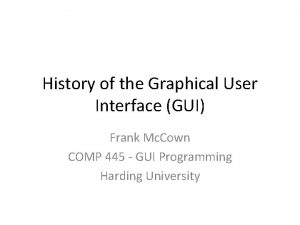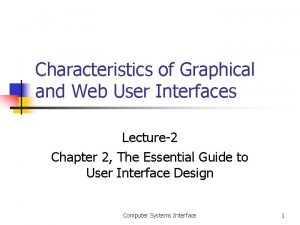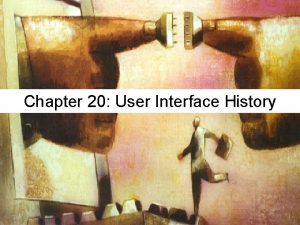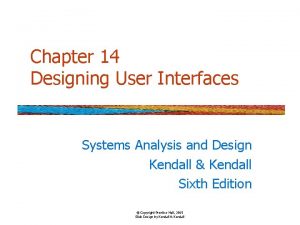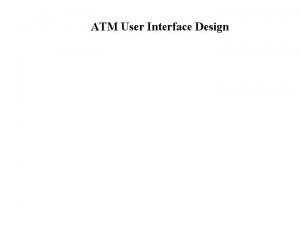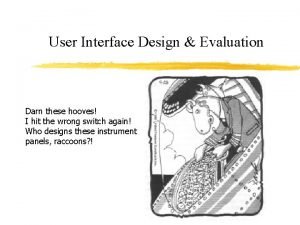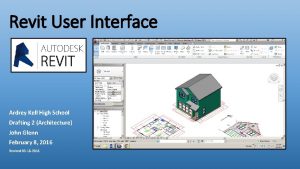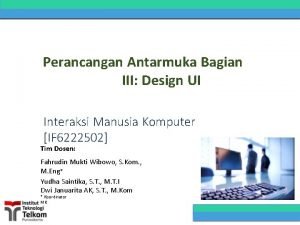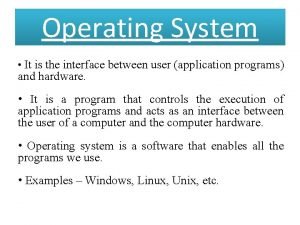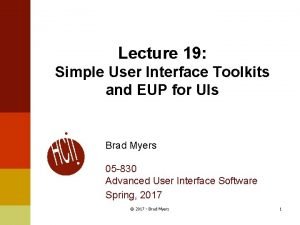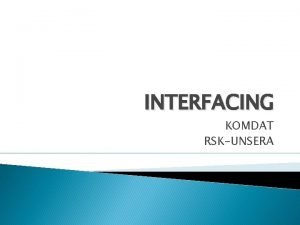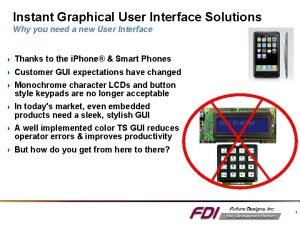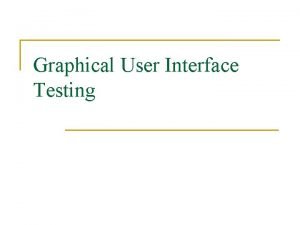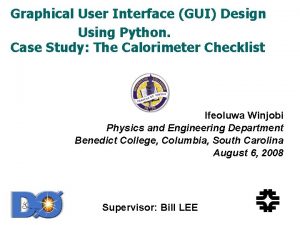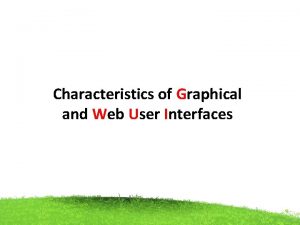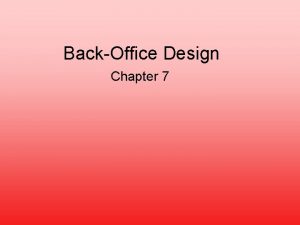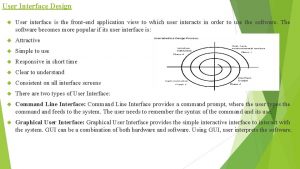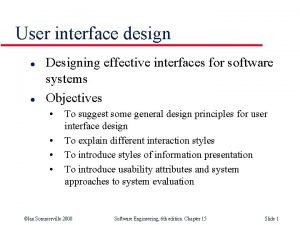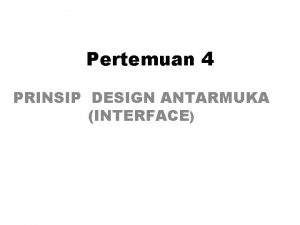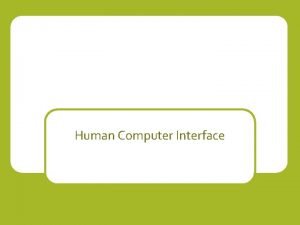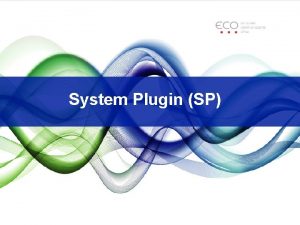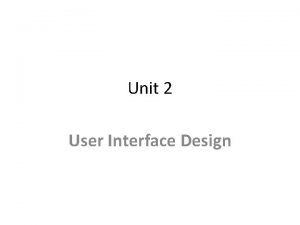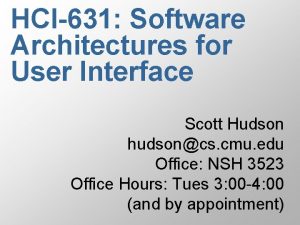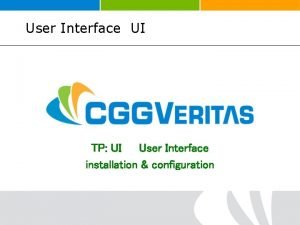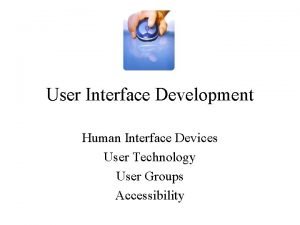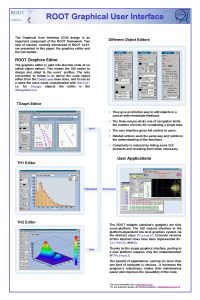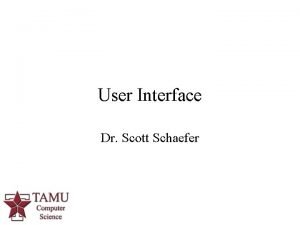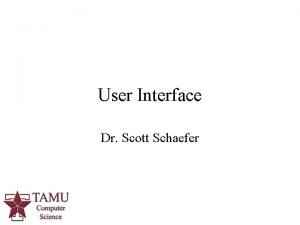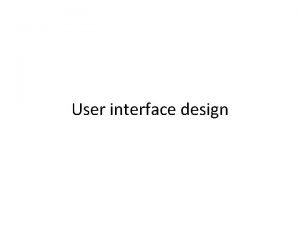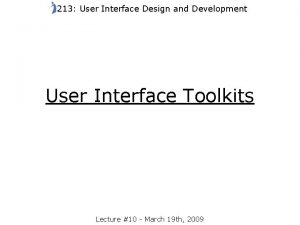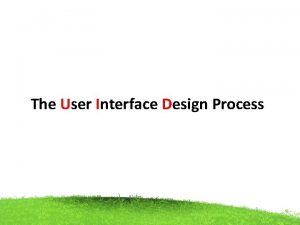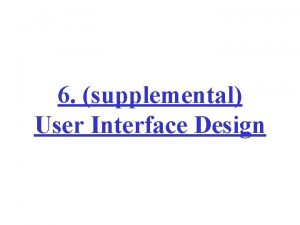Plugin Architectures Jeffrey Stylos User Interface Software Fall















![Emacs examples l [Show Tetris example] Emacs examples l [Show Tetris example]](https://slidetodoc.com/presentation_image_h/75bea330c630b857c91281cbca592cfb/image-16.jpg)









![XPCOM Examples l Using XPCOM: l l var sound = Components. classes["@mozilla. org/sound; 1"]. XPCOM Examples l Using XPCOM: l l var sound = Components. classes["@mozilla. org/sound; 1"].](https://slidetodoc.com/presentation_image_h/75bea330c630b857c91281cbca592cfb/image-26.jpg)








![Example XUL extensions l [Show Firefox and Thunderbird extensions] l [Thunderbird ¡ Contact extensions: Example XUL extensions l [Show Firefox and Thunderbird extensions] l [Thunderbird ¡ Contact extensions:](https://slidetodoc.com/presentation_image_h/75bea330c630b857c91281cbca592cfb/image-35.jpg)














![Sample Eclipse plug-in l [Show Hello. World Eclipse plug-in] Sample Eclipse plug-in l [Show Hello. World Eclipse plug-in]](https://slidetodoc.com/presentation_image_h/75bea330c630b857c91281cbca592cfb/image-50.jpg)






![Winamp 3 skins l [Show Winamp] Winamp 3 skins l [Show Winamp]](https://slidetodoc.com/presentation_image_h/75bea330c630b857c91281cbca592cfb/image-57.jpg)




- Slides: 61

Plug-in Architectures Jeffrey Stylos User Interface Software, Fall 2004

Introduction

Component architectures l What are components good for? ¡ Being able to reuse standard components within your own applications ¡ Allowing applications to be architected and implemented more modularly ¡ Allowing applications to be extended (by plugins) after they are compiled and released

What is a plug-in? l For my purposes, a plug-in is a piece of software that extends or changes the behavior or interface of an existing, compiled application

What are plug-ins good for? l Extending an application’s functionality l Changing the UI of an application (skins or themes) l Extracting data from an application ¡ To connect it to another app ¡ For logging

What are the issues with plug-in architectures? l What sort of plug-ins can you create? ¡ ¡ What aspects of the original program can you override? How difficult does this make it to create the base application? How are the plug-ins created and installed? Are they compiled? l How do plug-in authors debug their plug-ins? l l How you create an architecture that balance these different issues is an interesting research question

My goals for this lecture l Give an overview of several different examples of plug-in architectures and their capabilities and limitations l Give you an idea of what resources and tools to use if you want to create one of these plug-ins l Not to die from coughing

Why you should care about plug-in architectures Writing plug-ins is a way to connect your research with real applications, making it more compelling l Writing plug-ins is a relatively easy way to write software that can make your life easier l Building a plug-in architecture into your project is a way to let other people improve your project for you l Designing new plug-in architectures is a potentially fruitful research avenue l

DISCLAIMER l This wasn’t one of the existing topics ¡I picked it because I wanted to learn more, not because I was already an expert l These slides suck l I have a cough

Overview l Intro l Emacs l Mozilla l Eclipse l Skinnable apps

Emacs

Emacs l "Editor MACro. S“ l One of the first runtime extensible systems l Designed for text editing ¡ Used for everything l Contains a core written in C l The rest is written in elisp

Emacs extensions Extensions are written in elisp Can provide new functions or replace existing functionality l Most extensions are macros that provide some sort of automation when explicitly invoked l Can also do things like change text formatting l l ¡ ¡ l Can display images, but only in the context of lines of text Auto spell-checking (flyspell) It’s hard to: ¡ ¡ Write multi-threaded extensions (makes network programming difficult) Do arbitrary painting (assumes lines of text)

Emacs extensions (continued) l Everything loaded from initialization file l To install an extension ¡ Set the correct paths in the initialization file ¡ Load the extension from the initialization file l Can also manually load any lisp file, or even execute code as you write it

How do you debug extensions? l Because much of Emacs is in Lisp, can step through it l Has a built-in debugging mode l Extensions for more detailed debugging (Edebug) and profiling (ELP) l Don't have to build Emacs to run or debug an extension
![Emacs examples l Show Tetris example Emacs examples l [Show Tetris example]](https://slidetodoc.com/presentation_image_h/75bea330c630b857c91281cbca592cfb/image-16.jpg)
Emacs examples l [Show Tetris example]

Mozilla

Mozilla l Several different applications ¡ Current code base provides Mozilla 1. 8 l Netscape 7. 2 l Firefox 1. 0 l Thunderbird 1. 0 l ¡ Different from old Netscape (which also provided some extensibility) l Current extensibility features allow modification of the browser interface components (not just interactive webpage elements)

Mozilla extensibility architectures l XPCOM ¡ l XUL / Java. Script ¡ ¡ l User interface modification and scripting Also used for “themes” [XPConnect] ¡ l Heavier weight – supports C++ and other programming languages Bridges XPCOM and Javascript [XPInstall] ¡ Installation and package management

XPCOM l Cross-Platform COM ¡ A cross platform clone of COM ¡ Multi-threaded, but no remote support (not DCOM) l Used to create heavy-weight components that can be called by XUL and Java. Script elements l Code can be cross platform, but has to be recompiled

XPCOM (continued) l Used to implement much of Mozilla’s core functionality

XPCOM (continued) l Uses the IDL (Interface Definition Language) to specify capabilities ¡ ¡ ¡ IDL compiles to C++ Connects to Java. Script As with COM, XPCOM programming uses lots of interface pointers l §Bad: void Process. Sample(ns. Sample. Impl* a. Sample) { a. Sample->Poke(“hello”); } §Good: void Process. Sample(ns. ISample* a. Sample) { a. Sample->Poke(“Hello”); }

Using XPCOM l (Usually) compile ¡ Can needs Mozilla framework to be difficult to compile l Needs the Mozilla framework to debug component l Requires special tool to generate IDL specification l Can use XPCOM for programming other than Mozilla plug-ins, but few do

Debugging XPCOM components l Effective when you debug all of Mozilla l Tools for detecting memory leaks ¡ Bloat. View, Boehm GC Leak Detector, Refcount Tracing, Trace-Malloc, etc.

High level overview of XPCOM Mozilla plug-ins l Make a DLL that implements necessary methods (NSGet. Module, etc. ) l Create a IDL specification l Create an XPT specification from the IDL l Put everything in Mozilla’s components directory
![XPCOM Examples l Using XPCOM l l var sound Components classesmozilla orgsound 1 XPCOM Examples l Using XPCOM: l l var sound = Components. classes["@mozilla. org/sound; 1"].](https://slidetodoc.com/presentation_image_h/75bea330c630b857c91281cbca592cfb/image-26.jpg)
XPCOM Examples l Using XPCOM: l l var sound = Components. classes["@mozilla. org/sound; 1"]. create. Instance(); if (sound) sound. Query. Interface(Components. interfaces. ns. ISound ); l IDL: l l l [scriptable, uuid(1 BDC 2 EE 0 -E 92 A-11 d 4 -BCC 0 -0060089296 CB)] interface moz. IGPS : ns. ISupports { boolean Open(in string str. Device); boolean Close(); string Reason(in boolean b. Clear); readonly attribute double latitude; readonly attribute double longitude; readonly attribute double elevation; readonly attribute double gpstime; };

XPCOM resources l High level information ¡ http: //www. mozilla. org/projects/xpcom/ ¡ An l l. I Introduction to XPCOM http: //www-128. ibm. com/developerworks/webservices/library/coxpcom. html don’t know of any good tutorial for creating and compiling an XPCOM extension

Mozilla Plug-ins: XUL and Java. Script l Used to build the base Mozilla user interface l What most of the available extensions are written in l Uses XUL to specify the static layout of the UI elements l Uses Java. Script to specify how each of the elements interacts

XUL l “zool” l XML User-interface Language l Initial ambitions of also being a language for richer webpages (sort of works now) l Cross platform l Can be used to create stand alone applications (with difficulty)

XUL (continued) l Uses “overlays” to add new interface elements to existing interfaces ¡ Easy to add a new button to an existing form l Can also replace existing interface elements l Uses CSS to specify many of the formatting elements of the UI

How to write a XUL-based plug-in l Write a. xul and. js file in Notepad l Put in Mozilla’s extension directory

Debugging XUL and Java. Script plug-ins l Difficult – most common solution is trial and error ¡ l Prints out red error messages on the UI There exists a debugging tool ¡ ¡ Venkman Java. Script debugger …but it hasn’t worked with Firefox or Thunderbird for a year or so l Update: There’s a development branch that might work with some version of Firefox

Example XUL code l <? xml version="1. 0"? > l <!DOCTYPE window> l <? xul-overlay href="file: //src/HTML/moztests/sampleoverlay. xul "? > l l <window orient="vertical" xmlns="http: //www. mozilla. org/keymaster/gatekeeper/there. is. only. xul "> l l l l l <box orient="vertical"> <box orient="horizontal" flex="1"> <text value="Sample text number ONE"/> <spring flex="1"/> <text value="Sample text number TWO"/> </box> <box orient="vertical"> <text value="Sample text number THREE"/> <text value="Sample text number FOUR"/> </box> l <box id="extra. Stuff"/> l </box> l </window>

Example Java. Script / XUL code l l l function toggle. Contacts. Picker() { var sidebar. Box = top. document. get. Element. By. Id("sidebar-box"); var sidebar. Splitter = top. document. get. Element. By. Id("contacts-panesplitter"); var sidebar. State = sidebar. Splitter. get. Attribute("state"); var menu. Item = top. document. get. Element. By. Id("menu_show. Contacts"); var toolbar. Button = top. document. get. Element. By. Id("button-contacts"); l l l l if (sidebar. Box. hidden) { sidebar. Box. hidden = false; sidebar. Splitter. hidden = false; if (menu. Item) menu. Item. set. Attribute("checked", "true"); if (toolbar. Button) toolbar. Button. set. Attribute("checked", "true"); l . . . l l l
![Example XUL extensions l Show Firefox and Thunderbird extensions l Thunderbird Contact extensions Example XUL extensions l [Show Firefox and Thunderbird extensions] l [Thunderbird ¡ Contact extensions:](https://slidetodoc.com/presentation_image_h/75bea330c630b857c91281cbca592cfb/image-35.jpg)
Example XUL extensions l [Show Firefox and Thunderbird extensions] l [Thunderbird ¡ Contact extensions: sidebar ¡ Quote colors]

Themes l Uses the swap-ability of XUL elements to create plug-ins that change the appearance but not the functionality l [Show theme examples]

XUL and Java. Script resources l Lots, high-level overviews, reference sites, and examples l Because they are non-compiled languages, you can view the source of every current available extension

XUL / Java. Script overview l Powerful and flexible UI scripting ¡ ¡ Can override existing elements Can dynamically transform UI elements Provides support for separating formatting decisions into CSS files l Provides support for internationalization by separating text strings into language files l Don’t have to compile l l Hard to debug Can’t write arbitrary C code Potentially slow

Break

Eclipse

Eclipse l. A modern Emacs l Designed to have a very small core that loads independent components l Written in Java, primary selling point is its included Java developing components l “The Eclipse Platform is an IDE for anything, and for nothing in particular. ” l Cross platform

Eclipse (continued) Designed for building IDEs l People used it for other apps l ¡ l Remail, Haystack (new version) Now formalized: “Rich Client Protocol”

Eclipse architecture

Eclipse plug-ins l All written in Java l Found at Eclipse launch ¡ Heavier-weight than Emacs model – can’t dynamically swap plug-ins or write and execute code l Include a “manifest” file ¡ Specifies visibility of included classes and methods ¡ Used to add information to the plug-in registry

Manifest file example l l l <? xml version="1. 0" encoding="UTF-8"? > <plugin name="JUnit Testing Framework" id="org. junit" version="3. 7" l l l l provider-name="Eclipse. org"> <runtime> <library name="junit. jar"> <export name="*"/> </library> </runtime> </plugin>

Eclipse plug-in architecture Load-on-demand strategy makes it feasible to have many different plug-ins and still have reasonable performance l “Extension points” make it easy for plug-ins to themselves be extendable l ¡ ¡ l Uses “explicit ports” to make plug-in connections clear ¡ ¡ l Allows for multi-level extensibility (Most architectures only support a single level of extensibility) Plug-ins say what they can extend Helps support multi-layered extensibility Manifests help encapsulate plug-ins from each other (they can only use each other in specified ways) ¡ Again, helps multi-layered extensibility

Eclipse plug-in architecture (cont. ) l Limitations: ¡ Extensibility points are tied to specific implementations l Can’t have multiple swappable implementations of the same functionality ¡ Can’t have strict dependencies All components are optional l Can’t say “this plug-in only works when this other plug-in is available” l l Reference: Evaluating the Eclipse Platform as a Composition Environment

SWT and JFace l Standard Widget Toolkit ¡ ¡ Really just a widget set JFace is the higher-level toolkit built on top of SWT Allows for portable plug-ins that use native widgets l Usable outside of Eclipse l ¡ l Opinionated claim: Best Java widget set Supports widget extensibility by allowing Java extensions of native widgets

Different types of Eclipse plug-ins l Whole apps l C++ IDE (CDE) l Visual UI Editor (SWT/Swing Designer) l Aspect oriented language extension (Aspect. J) l Profiler (Eclipse. Profiler)
![Sample Eclipse plugin l Show Hello World Eclipse plugin Sample Eclipse plug-in l [Show Hello. World Eclipse plug-in]](https://slidetodoc.com/presentation_image_h/75bea330c630b857c91281cbca592cfb/image-50.jpg)
Sample Eclipse plug-in l [Show Hello. World Eclipse plug-in]

How do you debug your Eclipse plug-in? l Eclipse comes with tools to help build, run and debug Eclipse plug-ins ¡ Plug-in wizard ¡ Runs separate instances of Eclipse for developing and testing ¡ Provides support for the packaging of plug-ins ¡ Eclipse. Profiler plug-in

Eclipse resources l Many high level articles ¡ Most on eclipse. org l Relatively ¡ Archived l For active mailing list on eclipse. org, (poorly) searchable many things, only reference is the Eclipse source code

Skinnable Apps

Skinnable Apps l Is this research related? l Some history ¡ Remember l Winamp 1? (That’s an mp 3 player, by the way) ¡ Not intentionally skinnable ¡ Someone figured out how to modify the bitmap resources in the compiled Winamp executable ¡ Became wildly popular, then supported

Winamp 2 skins

Winamp 3 l More than just changing bitmaps l Let skin authors specify size and location of buttons, and simple scripting (MAKI scripts) l Used an XML-based language to define the location of UI elements, similar to resource editors
![Winamp 3 skins l Show Winamp Winamp 3 skins l [Show Winamp]](https://slidetodoc.com/presentation_image_h/75bea330c630b857c91281cbca592cfb/image-57.jpg)
Winamp 3 skins l [Show Winamp]

Sonique l (Another mp 3 player) l Flash-like graphic capabilities in a skin l [Show Sonique]

Skinnable Apps wrap up l Natural evolution of a separation between UI and underlying functionality l A form of end-user programming l Many limitations as a plug-in architecture ¡ Difficult to trap events ¡ Limiting even just considering UI capabilities

Conclusions l Different plug-in architectures support different type of extensibility l Plug-in programming is very different from regular GUI programming l Never get a cough before you have to give a presentation

Thanks! Good luck on homework 5!
 Xpcom thunderbird
Xpcom thunderbird J'ai deux stylos. veux-tu emprunter
J'ai deux stylos. veux-tu emprunter User interface in software engineering
User interface in software engineering User interface design in software engineering
User interface design in software engineering User interface design in software engineering
User interface design in software engineering User interface design process in software engineering
User interface design process in software engineering User interface prototyping in software engineering
User interface prototyping in software engineering Interface analysis in software engineering
Interface analysis in software engineering User interface design process in software engineering
User interface design process in software engineering Smart school biometric desktop plugin software
Smart school biometric desktop plugin software Interface in java
Interface in java Areas of the screen that behave as if they were independent
Areas of the screen that behave as if they were independent Office interface vs industrial interface
Office interface vs industrial interface An interface
An interface Yahoo user interface library (yui)
Yahoo user interface library (yui) What is xul
What is xul Graphical user interface testing
Graphical user interface testing User interface management system
User interface management system Enterprise architect interface
Enterprise architect interface Basic principle of input design
Basic principle of input design User interface design cycle
User interface design cycle User interface importance
User interface importance User interface analysis and design
User interface analysis and design Touch screen technology seminar
Touch screen technology seminar Characteristics of web user interface
Characteristics of web user interface Graphical user interface design principles
Graphical user interface design principles Interactible
Interactible User interface theory
User interface theory Mdi vs sdi
Mdi vs sdi Dibawah ini adalah komponen antar muka grafis, kecuali
Dibawah ini adalah komponen antar muka grafis, kecuali Introduction of gui
Introduction of gui Java user interface
Java user interface Hci user interface
Hci user interface History of user interface
History of user interface User interface feedback
User interface feedback Interface component
Interface component Cognitive walkthrough vs heuristic evaluation
Cognitive walkthrough vs heuristic evaluation Characteristics of graphical system
Characteristics of graphical system User interface history
User interface history User interface and its types
User interface and its types Atm ui design
Atm ui design User interface instagram
User interface instagram User interface design and evaluation
User interface design and evaluation User interface design in system analysis and design
User interface design in system analysis and design User interface revit
User interface revit Human interface designer
Human interface designer Interface between user and kernel
Interface between user and kernel Simple user interface
Simple user interface Apa pengertian antarmuka pemakai (user interface)
Apa pengertian antarmuka pemakai (user interface) User interface solutions
User interface solutions Gui meaning
Gui meaning Python user interface design
Python user interface design Dialog dalam konteks perancangan user interface adalah
Dialog dalam konteks perancangan user interface adalah Characteristics of graphical user interface
Characteristics of graphical user interface Visualization in user interface design
Visualization in user interface design Backoffice design
Backoffice design Frontend user interface
Frontend user interface Recoverability in user interface design
Recoverability in user interface design Input design system
Input design system Prinsip dasar user interface
Prinsip dasar user interface User interface uses the fewest system resources:
User interface uses the fewest system resources: Jpanel
Jpanel
